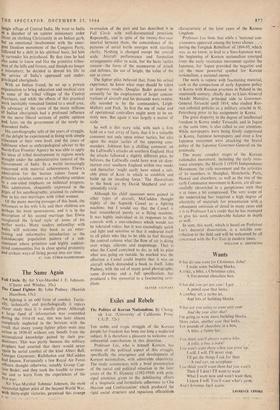The Same Again
Ea Circle. By Air Vice-Marshal J. E. Johnson. (Chatto and Windus, 35s.) AIR fighting is an odd form of combat. Tactic- ally, technically and psychologically it repays closer study than it is usually given. Although a large fond of information was assembled during the 1914-18 war, this was later almost completely neglected in the Services with the result that many young fighter pilots went into action in 1939-45 without any benefit from the accumulated knowledge gained by their pre- decessors. This was partly because the military Prophets had asserted that there would never again be aerial combat of the kind Albert Ball, Georges GUynemer, Richthofen and McCudden had known. Fortunately a few Royal Air Force officers thought otherwise, notably Group Cap- tain Bader, and they took' the trouble to exam- ine and to learn from the experiences of the first war.
Air Vice-Marshal 'Johnnie' Johnson, the most successful fighter pilot of the Second World War, with thirty-eight victories, perceived this strange
re-creation of the past and has described it in Full Circle with well-documented precision. Repeatedly, arid in spite of the twenty-five-year interim] between them, the concordance of the patterns of aerial battle emerges with startling clarity. Nothing is changed except the overall scale. Aircraft performance and formation arrangements differ in scale, but the basic tactics remain—the form of the manoeuvres of attack and defence, the use of height, the value of the sun as cover.
The fighter pilot believed that, from his actual experience, he knew what steps should be taken to improve results. Douglas Bader pressed in- cessantly for the employment of larger concen- trations of aircraft and his demands were eventu- ally acceded to by the commanders, Leigh- Mallory and Park. At first the use of radar and of, operational controllers might seem to be en- tirely new. But again it was largely a matter of scale.
So well is this story told, with such a firm hold on a vast array of facts, that it is a valuable comment not only upon minor tactics, but also upon the major tactics of the opposing com- manders. Johnson has a chilling comment on the Luftwaffe's attacks on southern England. Had the attacks followed a slightly different plan, he believes, the Luftwaffe could,have won air dom- ination over southern England within two weeks and thereafter `might easily have seized a suit- able piece of Kent in which to establish and build up an invading force.' The illustrations to the book are by David Shepherd and are splendidly vivid.
Although his chief successes were gained in other types of aircraft, McCudden thought highly of the Sopwith Camel as a fighting machine; but I would say that the Camel is best remembered purely as a flying Machine. It was highly individual in its responses to the controls with a one-sidedness which would not be tolerated today; but it was exceedingly quick and light and sensitive so that it endeared itself to all pilots who like to be able to feel through the control column what the flow of air is doing over wings, ailerons and empennage. That is what the Camel contrived to do; to tell its pilot what was going on outside. So marked was the affection a Camel could inspire that it was .an aircraft which demanded a book to itself. John Pudney, with the aid of many good photographs, some drawings and a full specification, has produced a fine memorial to a fascinating aero- plane.
• OLIVER S I LWAR




























 Previous page
Previous page